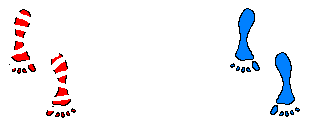
The Tracks of Peter Wampler
by John E. Wampler
Last update: 30Aug2004
 |
The Tracks of Peter Wampler
|
Section 1.5.d
Last update: 30Aug2004 |
|
NOTE: As of this version, some of the data reported here is based on second hand information. That is, the original records have not been examined. Rather, summaries, indices and records gathered by other genealogists and in various histories have been used. We have now begun to examine the original material first hand. When this has been done, an * is placed beside the reference. |
Central to several puzzles of Wampler/Wampfler genealogy in America is the personage of Peter Wampler in the colonial and early years of the republic (1740-1800). In terms of immigration records, two Hans Peter Wamplers are well documented, Hans Peter Sr. and his son Hans Peter Jr. Both of these Peter Wamplers came to the New World aboard the ship Lydia in 1741. The evidence for a third potential Peter Wampler of this era is less conclusive and the tracks are faint. They are mostly from land transactions indicating sales and purchases of land in Pennsylvania and Maryland both before the arrival and after the deaths our Hans Peters. As records have been examined, the tracks of this third possible Peter Wampler are becoming fainter. However, as of this version of the story, there is still the possibility that he existed.
The early transactions in Pennsylvania are geographically separate from the areas where Hans Peter Sr. and Jr. were known to reside (see map). The "story of Eve," a family tradition which suggests another lineage for her father Peter also makes a contribution to these faint footsteps. The fourth and fifth early Peter Wamplers were the son and grandson of Hans Peter Jr.'s brother Hans Michael. Only Michael's son, Peter, was an adult during the years before the turn of the century. This Peter Wampler lived in Virginia and no record suggests that he ever lived in Maryland or Pennsylvania as an adult. The time line in the Table below gives the dates, locations and actions that are on record for these various Peter Wamplers in the years from 1740 to 1800.
The general approach to the land record of 1740 and those after June, 1792, in Maryland has been to assume they are misdated or somehow the records of transactions carried out by an agent for one of the Hans Peter's. After his father's death in 1749, the Pennsylvania and Maryland records are then assigned to Hans Peter Jr. However, there are some transactions in Maryland that post-date even the death of Hans Peter Jr (June 1792). Examining these in the Frederick County Courthouse recently (Aug 2004), I find that one was clearly a posthumous transaction for the heirs (Libra WR N, folio 245). This was the most worrisome transaction since it was a purchase of land. Two other transactions represent land sales by Peter Wampler and his wife, Barbara (Libra WR 11, folio 11, dated 13 Aug 1792, and Libra WR 10 folio 706, dated 21 Jul 1792). Both are written as if the sales were by Peter and not his heirs. Both are witnessed and signed. In addition to these land transfers, Peter Wampler appears to have participated in an agreement amoung neighbors for a sale recorded in Libre WR 11 folio 662. This agreement is dated 12 July 1793, a good year after the death of Hans Peter Jr.
With this assumption about the land records, it is interesting to speculate on the life of Hans Peter Jr. in America. The recently available data (to this author) of the record of Peter's baptism into the Conestoga congregation of German Baptist Brethren (Dunkers, Dunkards or Tunkers) in 1754 helps make a bit more sense of his story. It reveals more about the dark time of his life when over a short period, his father dies, his wife is killed and Indians take four of his children. It helps explain the lack of christening records for some of his children, the move to Maryland and the marriage ties of his children to other early brethren families.
The Brethren baptism of Peter and Barbara in 1754 probably followed several years of their involvement with the Conestoga Congregation since it was the custom of this denomination for new members to learn the faith by participation before their baptism. Indeed, the last recorded role of Peter in a Lutheran congregation is his sponsorship of the baptism of his sister's son John Jacob Brennessen in November of 1749. It is interesting to note that the records of this event (Rev Stoever's records of the Evangelical Lutheran Church) say that this same sister, Veronica, and her husband, Jacob, left to become Tunkers sometime after this date. The list of the Little Swatara Congregation of Brethren from 1770 gives Jacob Breneisen and wife as members.
Since the Tunkers practiced only adult baptism, any children born to either of these families after their conversion would not have been christened and, thus, no christening records would be found concerning them. We should not be surprised, therefore, with the lack of hard data on the birth dates of Peter's children, a fact complicated no doubt by the raging Indian wars in their part of Pennsylvania in the 1740's and 1750's.
The note in the Conestoga baptism record about Barbara Wampler being "killed under a tree," while a bit cryptic, also fits with the times when many women and children were slain in Indian attacks and many carried off as hostages. The Brethren suffered great losses during these times. They were often settled at the very limits of the westward expansion and their beliefs prevented them from fighting back. This might explain why Peter's wife is not mentioned either as a hostage or casualty in the story of his children's abduction (she being already killed!).
The Conestoga Brethren congregation was the central brethren group in early Pennsylvania. They held the annual denominational meetings in many of the years from the first meeting in 1742 through the 1780's. Members of this congregation fanned out to other frontiers. The famous Ephrata Community was begun in part by the first leader of this congregation, J. Conrad Beissel. Michael Pfautz, the elder that baptized Peter and Barbara was the third leader of this early congregation ordained in 1748. His Baptismal Records from the Brethren web site show a steady rate of baptisms over his tenure as elder. Many of the names seen here are found in the marriage records of Hans Peter's line. These include ROYER, FLORY and WOLFE. Similarly, those found in several other of the Pennsylvania congregations will be familiar to Wampler genealogists including KINSEY (Oley and Conestoga congregations), HARTMANN (Conestoga congregation),
The contact between the Peter Wampler family and other Brethren families of wide ranging congregations at the annual meetings may also explain the marriages of his children into families such as the KINSEY's of Virginia (his daughter Eve), the GRAYBILL's (his daughter Christina), the GARBER's (his son John), the HARTMAN's (his daughter Ann) and the ENGLAR's (his daughter Philipena and possibly his son David) of Maryland. In the article describing annual meetings, the Brethren Encyclopedia says it was here where "new friendships [were] made and many first date ...led to marriage." In the early church, marriages were often arranged with the help of the church deacons. Marriage outside of the church was frowned on and could lead to shunning. Is this perhaps the reason the Peter's son David received so little inheritance in his father's will?
The move to Maryland may also be explained in part by Peter's religious faith. The Brethren were committed nonresistants. As the revolutionary war progressed, Pennsylvania enacted more and more punitive measures directed at the Tunkers, Mennonites and Quakers who would not serve in the military. Maryland, with lower populations of these sects, had less strict laws concerning them. Another writer has argued that the move down the Monocacy road to Maryland and on into Virginia was a consequence of the growth of the Pennsylvania congregations and the need for more farm land for their large families.
Their wills (see Peter's will and Barbara's will) make it clear that Peter married a second time to the widow Barbara Snither (Sneither) who had a son, Jacob. Together, they had a son Joseph. Peter's will names five sons -- David, Jacob, John, Daniel and Joseph-- and five daughters -- Barbara, Eve, Christania, Philiptenia and Ann. Maryland census records of 1790 list David, Jacob, Peter and Lod all of Frederick Count Maryland. After Hans Peter Jr's death, the 1800 census lists David, John and Ludwich in Frederick County and a Christian in Baltimore City. The wills suggests that Ludwich (Lod) and Christian were not Peter's sons (Ludwich was probably [jc2-2]). Peter's listing in 1790 gives 2 males greater than 16 years old, 1 under 16 and 3 females. His son John who married in 1790 was probably living at home then as was the youngest son Joseph. This would account for the three males in the 1790 census. One of the three women was his wife Barbara. One of the others may have been either their daughter Barbara Wampler Ward-- she is treated as a dependent in the will-- or John's new wife. The third may have been Cattharine Halberster, the servant girl named in Peter's will. By the 1800 census John is listed with (2 males under 10, himself between 26 and 45 years old, 2 female children <16, one 16 to 26-- probably his wife-- and one greater than 45 -- ?). This leaves Daniel and Barbara's son Jacob Snither to be accounted for. The 1790 census records of Maryland, Virginia and Pennsylvania do not list Daniel Wampler or Jacob Snither. Daniel may have moved to Pennsylvania. Jacob was executor of his mother's will in 1800.
The life of Hans Peter Jr. as imagined above was one of turmoil and adventure. Born in Alsace, traveling with his father as a young adult to the new world, he arrived in the time of the great turmoil of the French/Indian war. He changed his life in so many ways, not the least of which was his conversion to the Dunkers faith. He suffered the murder of his wife and kidnap of his children in the French and Indian War. Under the growing pressure in Pennsylvania against the nonresistant beliefs of his new faith, he sees the war with the Indians through, experiences the happy return of his children and then watches as a new nation emerges and yet another war begins. We can not know if his sentiments lay with the British during the Revolutionary War. This was certainly the case of many of the other members of the German Baptist Brethren. History does say that Pennsylvania became increasingly hostile to the pacifist sects. Perhaps under this pressure, in the midst of the war years, he relocates yet again to Maryland. He marries a widow with a child of her own, sees the end of the war and witnesses the formation of the new republic. His fortunes in these later years seem to have turned. At his death in 1792, he leaves a substantial estate, has seen most of his ten children well married and dies at the age of 70, the sire of an adventuresome lot that would push westward all the way to the Pacific in just a few generation.
 
|
1740, March 1 |
Peter Wampler purchased 200 acre of land, Bethel Township, Lebanon County, PA (History of Lebanon and Dauphine Counties, page 11). It has been argued that this purchase was made by someone else acting for either Hans Peter Sr. or Hans Peter Jr. before their arrival in the new world. Note that Bethel Township was an early Dunkard settlement. |
  |
1741, September 29 |
Immigration aboard Lydia of Hans Peter Sr. (age 40) and Hans Peter Jr. (age 18) Ships records have been examined. This record includes signatures of both Sr. and Jr. |
  |
1743, September 26 |
Peter Wampler married Anna Barbara Brenneisen (Breneisen). Anna daughter of Hans Valentine and Margaretha Breneisen. They were married by Rev. John Casper Stoever, Hill Lutheran Church, located 4 miles northwest of Lebanon Pennsylvania (North Annville Township). |
|
|
1749, March 16 |
Warrantee entered for Peter WAMBLER for 200 Acres, Lancaster County From Pennsylvania Archives Series 3, Vol 24, p 558. |
|
|
1749, April (approx.) |
Death of Hans Peter Sr. Peter died intestate, but wife Veronica and sons Hans Peter Jr. and Hans Michael signed an inventory on 30 April 1749. The inventory (see Shouse's book, p. 3-4) includes three hives of bees, three heifers, one cow with calf, three horses, and three sheep. |
  |
1749, November 1 |
Peter Wampler sponsored baptism of John Jacob Brennessen, son of Jacob Brennessen and Veronica Wampler Brennessen in the Evangelical Lutheran Church,. The church records (Henry Egle's "Notes and Queries" Vol 1898, page 233) indicated that Jacob & Veronica later left to become Tunkers (Dunkards). Veronica was Hans Peter Jr.'s sister. |
|
|
1754, April 14 |
Peter and Barbara Wampler (who "was killed under a tree") were baptized by Elder Michael Pfautz as members of the Conestoga Congregation of German Baptist Brethren (Lancaster County, PA.) This from "A History of the German Baptist Brethren" by Martin Grove Brumbaugh, Brethren Publishing House, Mount Morris, Illinois, 1899, reprinted 1961, pp. 310-311. See Abstract on the Brethren Web Site. |
|
|
1756, October 1 |
The reports of the children of Peter Wampler stollen by indians, East Hanover Township, PA. Several secondary records of this event have been published indicating that up to four children were "stolen." One is Daniel Rupp's History of Berks and Lebanon Counties, published in 1844. |
|
|
1759 |
Assessement of Peter Wampler recorded, Lebonon Township, Pennsylvania 100 acres Lands, 20 cultivated, 5 in winter grain, 2 horses, 3 sheep and 4 horned cattle. (History of Lebanon and Dauphine Counties, page 131; Sowers, "Colonial Taxes Lebanon Township, Lancaster County, Pennsylvania 1750-1783," page 40) |
|
|
1762 |
Peter Wampler paid taxes in Reading Township, Adams Co. PA. (from Shouse's Book). |
|
|
1765, August 7 |
Peter Wampler was granted a warrant for 200 acres in Chester Co. PA (from Souse's Book). |
|
|
1770 (approx.) |
Hans Michael's son Peter is born either in PA shortly before they moved to VA or in VA very soon after. |
|
|
1770, December 15 |
Record of land bought by Peter Wampler in Maryland from Richard Troxall (Liber N, folio 505) |
|
|
1787, July 30 |
Record of land purchased by Peter Wampler in Maryland from Christian Haass (Liber 7, folio 384) |
|
|
1789, April 18 |
Peter Wampler witnesses a transaction involving his father Michael and his brothers Michael Jr. and Stophel, Montgomery County, VA (deed book B, pages 35 & 36) Note: The Peter Wampler name is hard to read and looks like it is spelled Petrius Wampfler or Wamflier. |
|
|
1790 |
Census record for Peter Wampler, Frederick County Maryland, with 2 males over 16, 1 under 16 and 3 females. |
|
|
1792, June 30 |
Peter Wampler dies in Maryland. His will is entered into probate, Frederick Co. Maryland (Liber G. M. No. 2, Folio 444)Note. The will was signed June 8, 1792 and Wampler is spelled differently than in the other two signatures (passenger list signature from Lydia and signature when estate of Hans Peter Sr. was inventoried). |
|
|
1792, July 21 |
Peter Wampler sells land in Frederick Co. Maryland to Christian Haass (Liber 10, folio 706) |
|
|
1792, August 13 |
Peter Wampler sells land in Frederick Co. Maryland to Jacob Worman (Liber 11, folio 384) |
|
|
1794, March 10 |
Peter Wampler buys land in Frederick Co. Maryland from Samuel Chase (Liber 12, folio 245) |
|
|
1796, August 14 |
Anna Mary Wampler is born to Peter and Magdalena Wampler (Baptismal record of St. Paul's Lutheran Chruch, Wythe County VA) |
|
|
1799, January 15 |
Peter and Magdalena Wampler are witnesses to the Baptism of Leah Kinser, born to Jacob and Elizabeth Kinser, St. Paul's Lutheran Church, Wythe County VA |
|
|
1799, October 8 |
Joseph Wampler is born to Peter and Magdalena Wampler (Baptismal record of St. Paul's Lutheran Church, Wythe County, VA). |
|
|
1800 |
No Peter Wampler in the MD census of 1800 |
|
|
1802, March 29 |
Personal property tax for Wythe County VA list Peter Wampler with 3 horses, mares, colts or mules. |
|
|
1805, July 15 |
Peter (son) listed in Father's estate settlement, Wythe County, VA. Peter is also a party to a transfer recorded in the property settlement (Deed Book 4, pages 361-362, Wythe County, VA) |
|
|
1806, March 23 |
Peter and wife are sponsors for baptism of Jefferson Wampler, son of Henry and Maria Wampler, at Zion Lutheran Church, Wythe County VA. |